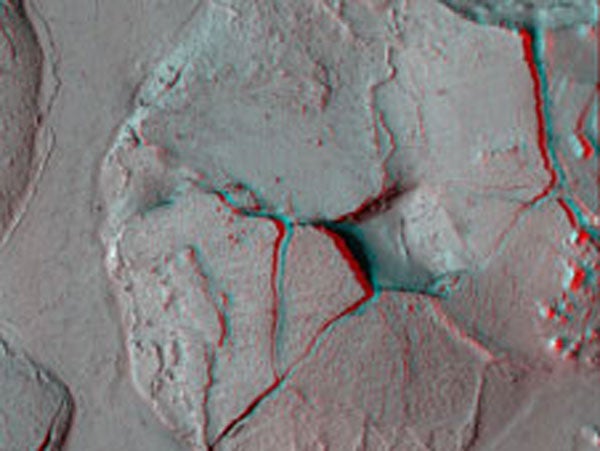Other Mars-orbiting cameras have taken 3-D views of Mars, but the HiRISE camera — the most powerful camera ever to orbit another planet — can resolve features as small as 40 inches (1 meter) across.
“It’s really remarkable to see martian rocks and features on the scale of a person in 3-D,” said HiRISE principal investigator Alfred McEwen of The University of Arizona’s Lunar and Planetary Laboratory. “The level of detail is just much, much greater than anything previously seen from orbit.”
Viewers need to use red-cyan filter glasses to see the 3-D effect.
Seen in HiRISE 3-D, Mars becomes a collection of deep panoramic views that leap out from the computer screen.
“You’d swear you could touch the terrain,” HiRISE Operations Manager Eric Eliason said.
Striking stereo views include:
Other dramatic anaglyphs show a huge jumbled mass of rock that includes megabreccia at a central peak in Ritchey crater, ejecta-formed channels and mudflows at Hale crater, tightly folded rock layers lining the floor of Tithonium Chasm, “spiders” created by carbon dioxide venting through south polar layered deposits, and martian glacier flows.
Eliason and the team at the High Resolution Imaging Operations Center (HiROC), on The University of Arizona campus, began processing stereo images in October. They automated some of the software used in processing HiRISE images so two images of a stereo pair could be fed into the software “pipeline” and correlated automatically.
“The real advance here is making this process semi-automated so we can crank through these huge images,” McEwen said. Producing anaglyphs from stereo pairs is otherwise a tedious, time-consuming effort.
The HiRISE camera has so far taken 950 stereo image pairs. The camera features a 20-inch (.5-meter) diameter primary mirror and a focal plane mechanism that can acquire up to a 3.6 mega-pixel image in about 11 seconds.
The anaglyphs are among 1,642 observations containing 3.6 terabytes of data and 148,000 image products that HiRISE released December 8, 2008, to the Planetary Data System (PDS), the NASA mission data archive.
Since HiRISE began the science phase of its mission in November 2006, the HiRISE team has released a total 867,430 image products, or 30.2 terabytes of data. That is by far the greatest volume of data a space experiment has delivered to the PDS, and well more than twice the data volume some HiRISE team members expected to get during the primary science phase.
The HIRISE camera was designed to take images at high-convergence angles so researchers can calculate the thickness of surface features to within about 10 inches (25 centimeters). High-convergence angles used to get quantitative measurements aren’t always best for making anaglyphs, McEwen said.
In addition, if the two stereo images on two different orbits were taken far enough apart in time, the illumination or air opacity may have changed, or frost or dust devils may have appeared in one of the images, so paired images don’t always match that well, he said.
“Nevertheless, many of these stereo anaglyphs are very interesting and useful to us in understanding the topography,” McEwen said.
“There’s a lot of science to be done by just looking at these directly and understanding what’s up and what’s down,” he said. “Anaglyphs can definitely change how we interpret things and help us focus on how to proceed when it comes to prioritizing some science tasks.”










